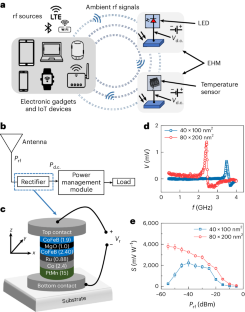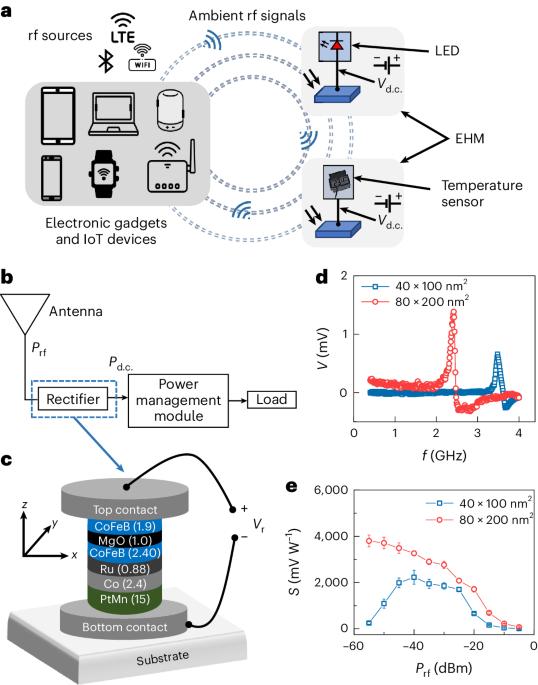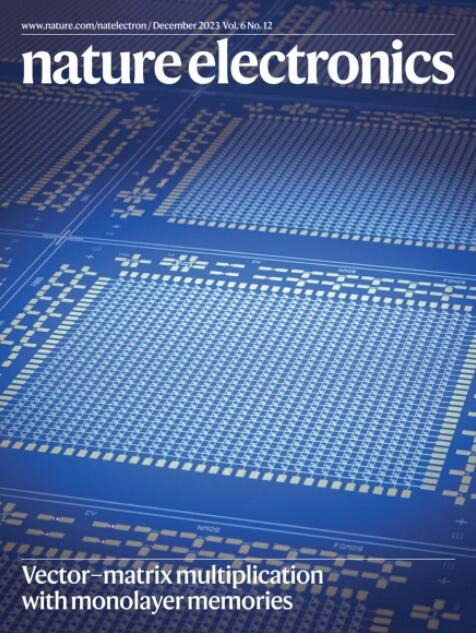Nanoscale spin rectifiers for harvesting ambient radiofrequency energy
IF 40.9
1区 工程技术
Q1 ENGINEERING, ELECTRICAL & ELECTRONIC
引用次数: 0
Abstract
Radiofrequency harvesting using ambient wireless energy could be used to reduce the carbon footprint of electronic devices. However, ambient radiofrequency energy is weak (less than −20 dBm), and the performance of state-of-the-art radiofrequency rectifiers is restricted by thermodynamic limits and high-frequency parasitic impedance. Nanoscale spin rectifiers based on magnetic tunnel junctions have recently demonstrated high sensitivity, but suffer from a low a.c.-to-d.c. conversion efficiency (less than 1%). Here we report a sensitive spin rectifier rectenna that can harvest ambient radiofrequency signals between −62 and −20 dBm. We also develop an on-chip co-planar-waveguide-based spin rectifier array with a large zero-bias sensitivity (around 34,500 mV mW−1) and high efficiency (7.81%). The performance of our spin rectifier array relies on self-parametric excitation, driven by voltage-controlled magnetic anisotropy. We show that these spin rectifiers can be used to wirelessly power a sensor at a radiofrequency power of −27 dBm. Sensitive spin rectifier devices can be used to create rectennas that harvest ambient radiofrequency signals between –62 and –20 dBm, and can be used to create on-chip co-planar-waveguide-based spin rectifier arrays with large zero-bias sensitivity and high efficiency.


用于采集环境射频能量的纳米级自旋整流器
利用环境无线能量进行射频采集可减少电子设备的碳足迹。然而,环境射频能量较弱(低于-20 dBm),而且最先进的射频整流器的性能受到热力学限制和高频寄生阻抗的制约。基于磁性隧道结的纳米级自旋整流器最近已显示出较高的灵敏度,但其交流到直流的转换效率较低(不到 1%)。在这里,我们报告了一种灵敏的自旋整流器整流天线,它能接收-62 到 -20 dBm 的环境射频信号。我们还开发了一种基于共平面波导的片上自旋整流器阵列,具有高零偏压灵敏度(约 34,500 mV mW-1)和高效率(7.81%)。我们的自旋整流器阵列的性能依赖于由电压控制的磁各向异性驱动的自参数激励。我们的研究表明,这些自旋整流器可用于以 -27 dBm 的射频功率为传感器无线供电。
本文章由计算机程序翻译,如有差异,请以英文原文为准。
求助全文
约1分钟内获得全文
求助全文
来源期刊

Nature Electronics
Engineering-Electrical and Electronic Engineering
CiteScore
47.50
自引率
2.30%
发文量
159
期刊介绍:
Nature Electronics is a comprehensive journal that publishes both fundamental and applied research in the field of electronics. It encompasses a wide range of topics, including the study of new phenomena and devices, the design and construction of electronic circuits, and the practical applications of electronics. In addition, the journal explores the commercial and industrial aspects of electronics research.
The primary focus of Nature Electronics is on the development of technology and its potential impact on society. The journal incorporates the contributions of scientists, engineers, and industry professionals, offering a platform for their research findings. Moreover, Nature Electronics provides insightful commentary, thorough reviews, and analysis of the key issues that shape the field, as well as the technologies that are reshaping society.
Like all journals within the prestigious Nature brand, Nature Electronics upholds the highest standards of quality. It maintains a dedicated team of professional editors and follows a fair and rigorous peer-review process. The journal also ensures impeccable copy-editing and production, enabling swift publication. Additionally, Nature Electronics prides itself on its editorial independence, ensuring unbiased and impartial reporting.
In summary, Nature Electronics is a leading journal that publishes cutting-edge research in electronics. With its multidisciplinary approach and commitment to excellence, the journal serves as a valuable resource for scientists, engineers, and industry professionals seeking to stay at the forefront of advancements in the field.
 求助内容:
求助内容: 应助结果提醒方式:
应助结果提醒方式:


